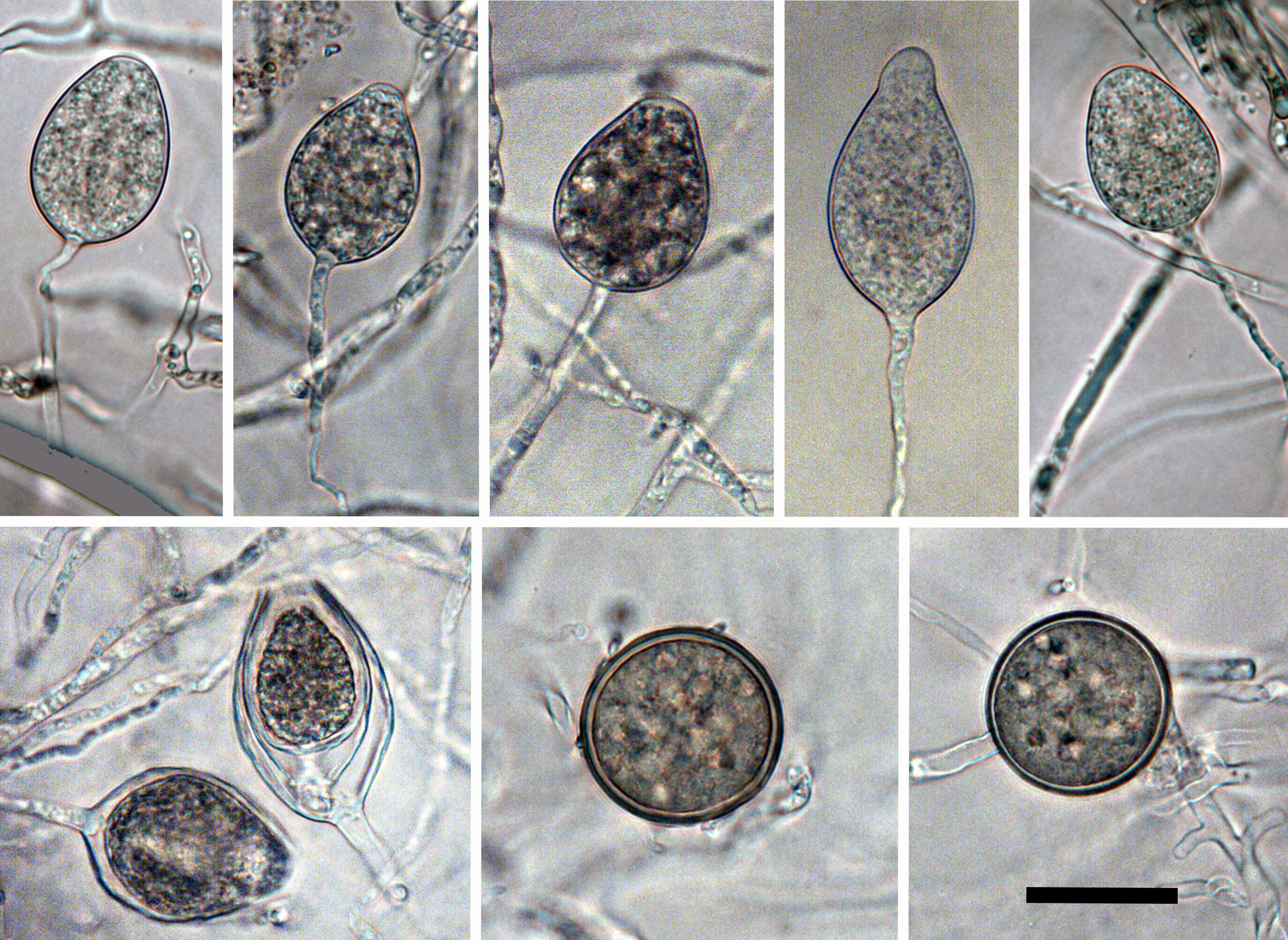Phytophthora cacuminis
|
Phytophthora spp. in subclade 9d: portion of the seven-loci ML phylogeny featuring the type cultures of 212 described species (by T. Bourret). Notice the position of P. cacuminis Ex-type CBS 144709. Gloria Abad, USDA S&T.
|
|
Phytophthora spp. in subclade 9d: Morphological Tabular key (PDF) and Tabular key legends (PDF) in IDphy2 KEY SECTION. Notice the data of P. cacuminis Ex-type CBS 144709. Gloria Abad, USDA S&T.
|
|
colony morphology after 5 d growth at 20ºC on carrot agar, V8 agar, malt extract agar, and potato-dextrose agar (from left to right) |
|
persistent, non-papillate, predominantly ovoid sporangia with internal proliferation; chlamydospores are common; scale bar = 25µm |
Name and publication
Phytophthora cacuminis I. Khaliq & T.I. Burgess (2019)
Khaliq I, Hardy GE, McDougall KL, Burgess TI. 2019. Phytophthora species isolated from alpine and sub-alpine regions of Australia, including the description of two new species; Phytophthora cacuminis sp. nov and Phytophthora oreophila sp. nov. Fungal Biology 123 (1): 29–41.
Corresponding author: tburgess@murdoch.edu.au (T.I. Burgess).
Nomenclature
Mycobank
Etymology
The species name cacuminis is derived from a Latin word ‘cacumen’ for a ‘peak’. The name is given to the species based on its isolation from a mountain peak in Tasmania.
Typification
Type: AUSTRALIA south Australia: Tasmania, Mount Field NP, from symptomatic Eucalyptus coccifera, May 2016, collected by Treena Burgess, isolated by I. Khaliq. holotype MURU 482 (dried culture on V8A, Herbarium of Murdoch University, Western Australia)
Ex-type: culture CBS 144709 = U40
Sequences of ex-type in manuscript: ITS MG542997, ß-tubulin MG543045, HSP90 MG543032, cox1 MG543010, nadh1 MG543019
Ex-type in other collections
(ET) CBS 144709, U40
Molecular identification
Voucher sequences for barcoding genes (ITS rDNA and COI) of the ex-type (see Molecular protocols page)
Phytophthora cacuminis ITS rDNA, COI
Voucher sequences for Molecular Toolbox with seven genes (ITS, β-tub, COI, EF1α, HSP90, L10, and YPT1
(see Molecular protocols page) (In Progress)
Voucher sequences for Metabarcoding High-throughput Sequencing (HTS) Technologies [Molecular Operational Taxonomic Unit (MOTU)]
(see Molecular protocols page) (In Progress)
Sequences with multiple genes for ex-type in other sources
- NCBI: Phytophthora cacuminis
- EPPO-Q-bank: Phytophthora cacuminis
- BOLDSYSTEMS: Phytophthora cacuminis
Position in multigenic phylogeny with 7 genes (ITS, β-tub, COI, EF1α, HSP90, L10, and YPT1)
Clade clade:
a taxonomic group of organisms classified together on the basis of homologous features traced to a common ancestor
9d
Morphological identification
Colonies and cardinal temperatures
Colonies had a halo of submerged hyphaehyphae:
single, tubular filament of a fungal or oomycete thallus; the basic structural unit of a fungus or oomycete
on CA, plumose growth pattern on V8A, uniform growth on MEA, and dense growth on half PDA. Minimum growth temperature 4°C, optimum 20°C, and maximum 25°C.
Conditions for growth and sporulation
SporangiaSporangia:
sac within which zoospores form, especially when water is cooled to about 10°C below ambient temperature; in solid substrates, sporangia usually germinate by germ tubes
are produced in water cultures (soil extract or river water) and not observed in solid media. OogoniaOogonia:
the female gametangium in which the oospore forms after fertilization by the antheridium
not formed in culture even when paired with different mating types.
Asexual phase
SporangiaSporangia:
sac within which zoospores form, especially when water is cooled to about 10°C below ambient temperature; in solid substrates, sporangia usually germinate by germ tubes
were non-papillate, persistentpersistent:
pertaining to sporangia that remain attached to the sporangiophore and do not separate or detach easily (cf. caducous)
, and predominantly ovoidovoid:
egg-shaped, with the widest part at the base of the sporangium and the narrow part at the apex
in shape with internal proliferationinternal proliferation:
internal proliferation occurs when the sporangiophore continues to grow through an empty sporangium
, both nested and extended. SporangiaSporangia:
sac within which zoospores form, especially when water is cooled to about 10°C below ambient temperature; in solid substrates, sporangia usually germinate by germ tubes
averaged 27.4 x 22.4 µm (overall range 14.5–40.2 x 10.8–37.3 µm). Sporangiophores simple (often twisted and narrow). Hyphal swellings absent. ChlamydosporesChlamydospores:
an asexual spore with a thickened inner wall that is delimited from the mycelium by a septum; may be terminal or intercalary, and survives for long periods in soil
present.
Sexual phase
Sterile in culture.
Most typical characters
Phytophthora cacuminis closely resembles P. fallax; the most distinguishing characteristics are that it is sterile in culture and has a low temperature maxima for growth.
Specimen(s) evaluated
Australia, Tasmania, Mount Field National Park, from rhizosphere soil collected symptomatic Eucalyptus coccifera, TI Burgess, 2016, CBS 144708 = U40 and U41
Hosts and distribution
Distribution: Australia
Substrate: roots
Disease note: no known disease
Host: native vegetation
Additional references and links
- SMML USDA-ARS: Phytophthora cacuminis
- EPPO Global Database: Phytophthora cacuminis
- Forest Phytophthoras of the World: Phytophthora cacuminis
- CABI Digital Library: Phytophthora cacuminis
- Encyclopedia of Life (EOL): Phytophthora cacuminis
- Index Fungorum (IF): Phytophthora cacuminis
Fact sheet author
Treena Burgess, Ph.D., Phytophthora Science and Management, Harry Butler Institute, Murdoch University, Australia
Z. Gloria Abad, Ph.D., USDA-APHIS-PPQ-S&T Plant Pathogen Confirmatory Diagnostics Laboratory (PPCDL), United States of America.



